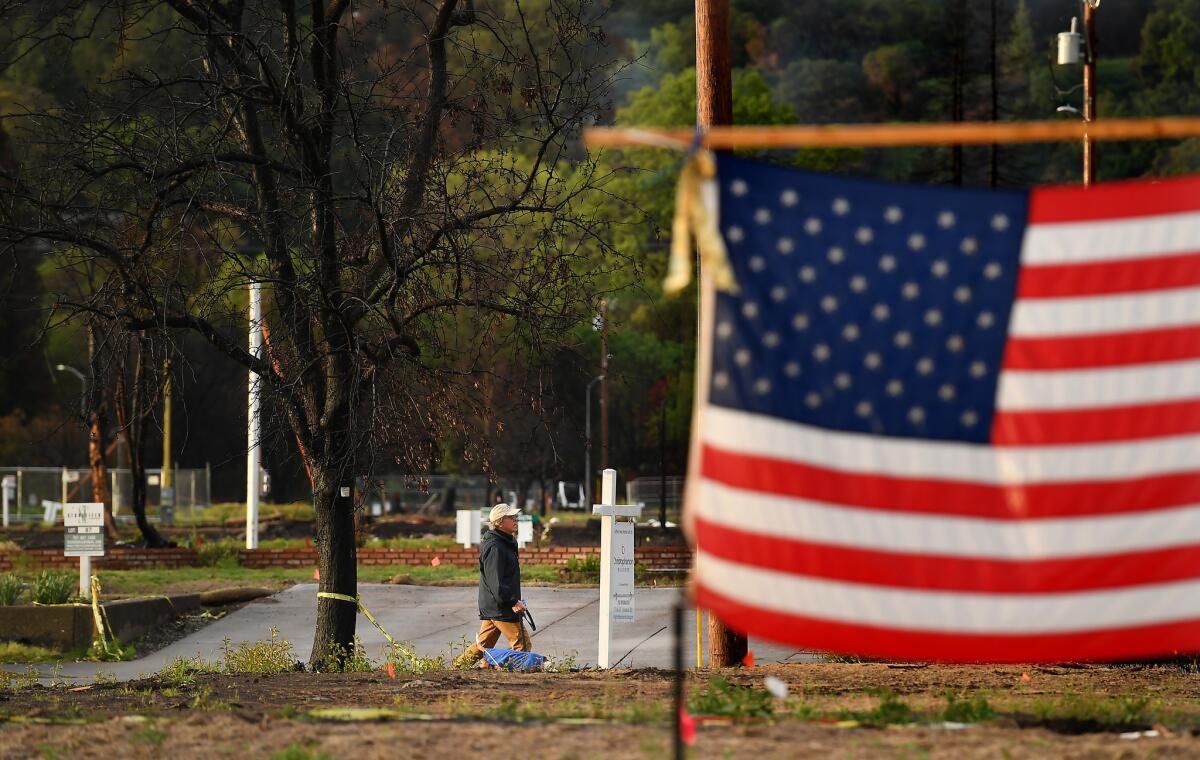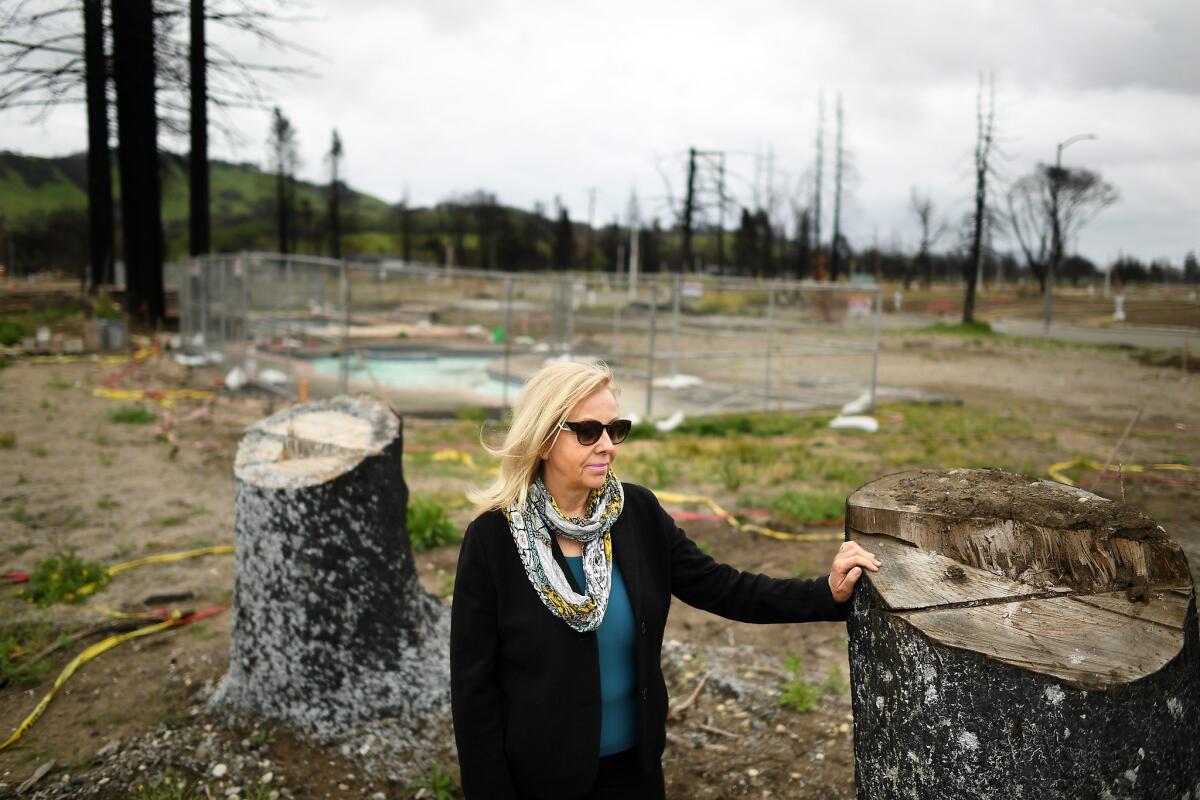Column: The perils of rebuilding after a devastating wildfire: toxic water, contaminated soil and woefully inadequate insurance policies

- Share via
Like so many fire victims who escaped with nothing but their lives, 68-year-old Dorothea Shipp had decided to leave California.
She’d been traumatized by the catastrophic fire that destroyed every home in her Santa Rosa neighborhood in October.
She would sell the lot where her beloved home once stood off Mark West Springs Road, cash out her insurance policy and move to Arizona with her dachshund Erich to start a new life.
“I’m not normally a person who cries, but I was pretty depressed, and a little crazed,” she said. “Flying off the handle every five minutes.”
But Shipp, who retired from her wine sales job last year, had a change of heart after her brother pleaded with her to stay. “He said, ‘If you leave California, it will break my heart. Please don’t go.’ ”
She also remembered some good advice she got 30 years ago after an unexpected divorce.
“My psychologist said, ‘Do you want to come here every week and sit on my sofa and cry your eyes out? Or do you want to do something?’ And I said, ‘I guess I am going to do something.’ ”
She snapped out of her gloom. She asked friends and relatives to send photos, which helped take the edge off losing her family history. And then, because she loved her 17-year-old home, she tracked down the original building plans.

“The builder said, ‘This is music to my ears,’ and he moved on it like a duck on a June bug,” she said.
Unlike many other fire victims whose policies will not nearly cover replacement costs, her insurance will cover all but $30,000 of her estimated $600,000 in construction costs.
Although State Farm will pay her $2,400 monthly rent on her two-bedroom condo for two years, she plans to be back home long before her insurance runs out.
“I am going to be in there,” she told me this week, “before the year ends.”
::
Nearly 6,000 homes and other structures burned down in the deadly wildfires that incinerated parts of Napa, Sonoma and Mendocino counties in October. Entire neighborhoods were wiped out. More than 40 people died.
To many, it seemed as if the reconstruction would be arduous but straightforward: Clear the debris, get the permits, start rebuilding. It has been anything but.
Hazardous substances have been found in soils affected by the fire. Septic and water systems have been impacted. Utilities were destroyed. In the Fountaingrove neighborhood north of downtown Santa Rosa, the entire water system will have to be replaced after cancer-causing benzene from melted plastics contaminated it.
As of the end of March, only 54 building permits had been granted in Sonoma County. About 200 vacant lots are on the market, and 72 others have been sold. Shipp is one of the first homeowners here to have broken ground on a new home. Many homeowners were underinsured, can’t afford to rebuild what they had and are selling their lots.

Most of Shipp’s neighbors, she said, are moving on. Of course, you can’t tell any of that by looking at her Berry Brook subdivision just east of Highway 101; it’s all dirt lots, marked off, in some cases by surveyors’ flags, hurricane fencing around empty swimming pools and the occasional “for sale” sign.
One of the rebuilding challenges is that nobody really knows how much a vacant lot should cost. In the beginning, at least, there were no comparative sales figures. “It’s a scientific wild-ass guess,” said Rick Laws, a Sonoma County real estate expert who offered a seminar this week to local agents about the challenges involved in selling “firestorm lots.”
Builders from all over California and beyond have made forays into the market. Some have purchased several lots in order to build spec homes. Others have tried to contract with multiple homeowners who are staying and rebuilding. “They’ll say, ‘We have six floor plans to choose from and we need 10 of you to rebuild with us to make it worth our while,’” Laws said.
But it’s fairly slow going.
“If we have 50% of the housing stock we lost rebuilt in five years,” Laws said, “I will be surprised.”
::
Six months on, the fire debris and cloying smell of smoke are gone. The melted cars and charred chimneys that gave suburban neighborhoods like Fountaingrove and Coffey Park the look of burned-out hellscapes are but memories. Foundations have been broken up and carted away.
“I don’t think one home here will have a saved foundation,” said Sylvia West, a Santa Rosa real estate agent who has listings for three lots off Mark West Springs Road. “The intensity of this fire was so hot that it compromised the cement.”

That, she said, was a lesson learned in the Oakland hills firestorm of 1991, in which foundations that were thought to be OK were later found to have been damaged by the intense heat.
As long as it will take for the physical scars to heal, the emotional ones may never fade. West’s uncle Art Grant, 95, and his wife, Suiko Grant, 75, died at their Santa Rosa home on Riebli Road. They were asphyxiated with their dog after seeking shelter in their wine cellar.
On Wednesday, in a drizzle, West and I drove around looking at empty lots. We parked at 170 Pacific Heights Drive in the Mark West Estates, a lot she is selling for $275,000. The owners were planning a move to Texas and were readying the house for market when the fire destroyed it.
Financially, they won’t suffer, West said, and they thank their insurance agent for that. Every year, the agent bugged them about updating their policy.
On some blocks, clumps of bright orange California poppies seemed like a hopeful rebuke to the blackened, once-magnificent redwood trees that still tower over dirt yards now covered with straw.
“It was a beautiful neighborhood,” West said. “I think it will be beautiful again.”
Twitter: @AbcarianLAT
Sign up for Essential California
The most important California stories and recommendations in your inbox every morning.
You may occasionally receive promotional content from the Los Angeles Times.








